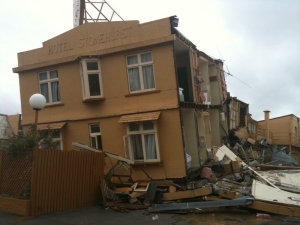After doing my feature on social media and the journalist, I decided to create a glossary of social media websites which detail on their relevance to journalism.
 Blogger is a blog-publishing service that allows private or multi-user blogs with time-stamped entries. It was bought by Google in 2003.
Blogger is a blog-publishing service that allows private or multi-user blogs with time-stamped entries. It was bought by Google in 2003.
Blogger was created to give the public an easy way to share their thoughts about current events, what’s going on in their life, or anything else they’d care to discuss with the world. Blogger has developed a host of features to make blogging as simple and effective as possible
Blogger encourages people to post text, photos, videos and more, and as often as they want; it’s free. When you create your blog, you can host it for free on Blog*Spot by choosing an available URL.
Digg is a social news website, launched in 2004. It is made for people to discover and share content from anywhere on the Internet, by submitting links and stories, and voting and commenting on submitted links and stories. Topics that are discussed include business, entertainment, gaming, lifestyle, offbeat, politics, science, sports, technology, and world news.
Voting stories up and down is the site’s cornerstone function, respectively called digging and burying. Many stories get submitted every day, but only the most Dugg stories appear on the front page.
Founded in 2004, Facebook’s mission is to give people the power to share and make the world more open and connected. Millions of people use Facebook everyday to keep up with friends, upload an unlimited number of photos, share links and videos, and learn more about the people they meet.
According to mashable, one of the key advantages of Facebook over other social platforms is the sheer number of potential sources it presents for journalists. By using tools such as Openbook or FBInstant on Facebook, journalists are able to find information they are looking for that is tied to specific news events or people. The trend toward more public information with new features on the site, such as Facebook Questions, which is entirely public, will only further Facebook’s utility as a tool for journalism.
More info on Facebook’s benefits as a journalistic tool available on mashable.
Flickr is an image hosting and video hosting website acquired by Yahoo! In addition to being a popular website for users to share and embed personal photographs, the service is widely used by bloggers to host images that they embed in blogs and social media. In September 2010, it reported that it was hosting more than 5 billion images. For mobile users, Flickr has an official app for iPhone, BlackBerry and for Windows Phone 7, but not for other mobile devices.
According to Flickr, there has been 4,390 uploads in the last minute and 4.3 million tags so far this month. The website was set up as a community for people who love photography to share their photographs.
Flickr says that their “companion blog to Flickr is almost certainly the best online photo management and sharing application in the world.”
Launched in May 2003, it is mainly used for professional networking. As of March 2011, LinkedIn reports more than 100 million registered users, spanning more than 200 countries and territories worldwide.
Twitter is based in San Francisco, but it is used by people in nearly every country. According to Twitter, on average 95 million tweets are written every day. Celebrating its fifth birthday last week, Twitter has become an essential tool to inform the masses during a crisis. Anyone and everyone can enjoy the benefits of Twitter. You are free to tweet as little or as much as you please as long as the message is 140 characters or below. Retweeting is action that helps to spread a certain message. This form of social media, like many others, is available on mobile devices through its free app.
Today, the process of journalism is taking place in public on media platforms such as Twitter. Breaking news becomes a process of publish, then filter. The journalistic functions of verification and authentication take place in public, done by both professional journalists and citizens.
After founded in 2005 by Chad Hurley and Steve Chen, within 18 months the website became one of the most trafficked on the web. The company was sold to Google for $1.6 billion.
In 2009, Youtube has made it easier for citizen journalists to upload their videos. As soon as the Youtube Direct channel had been launched, it was being used by The Huffington Post and The Washington Post.
The YouTube Direct is a new tool that allows media organisations to request, review and rebroadcast YouTube clips directly from YouTube users. The channel is built from YouTube’s APIs and is an open source application which lets media organisations upload platform on their own websites. Users can upload videos directly into this application, which also enables the hosting organization to easily review video submissions and select the best ones to broadcast on-air and on their websites.
For more information about this launch look refer to the article on the Independent.
And what made this all possible…Web 2.0
Web 2.0 is the popular term for advanced Internet technology and applications including blogs, wikis, RSS, and social bookmarking. The two major components of Web 2.0 are the technological advances enabled and the user empowerment that they support. Tim O’Reilly is generally credited with inventing the term.
One of the most significant differences between Web 2.0 and the traditional World Wide Web (Web 1.0) is greater collaboration among Internet users and other users, content providers, and enterprises.
Originally, data was posted on Web sites, and users simply viewed or downloaded the content. Increasingly, users have more input into the nature and scope of Web content and in some cases exert real-time control over it.

















